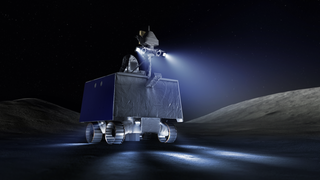NASA Selects USGS Scientist to Join the VIPER Science Team
Picture yourself as a scientist who has wanted to explore the Moon since their childhood and then NASA invites you to join the Volatile Investigating Polar Exploration Rover (VIPER) mission, which is set to launch in 2023: imagine the emotion! Eight lucky scientists, including our very own Dr. Laszlo Kestay, have been competitively selected to join the team.
Dr. Laszlo Kestay, surname also known as Keszthelyi, is a planetary volcanologist at the U. S. Geological Survey's Astrogeology Science Center, in Flagstaff, Arizona. In recent years, he has been heavily involved in efforts at the USGS to investigate lunar and asteroid resources.
Kestay’s scientific expertise and proposal, "Ground truth for lunar resource assessments," won him a seat on the team to contribute to VIPER mission planning. The team will utilize VIPER to explore the lunar South Pole in search of resources.
Dr. Sarah Noble, who leads the VIPER mission said, “These additions to the science team will provide new and fresh perspectives, enhance the expertise in critical areas, and really allow the team to get the maximum science value out of the VIPER mission." One of the strengths of the VIPER mission is the many collaborations that it will take for the mission to be successful, within NASA and beyond, including with the USGS.
VIPER, NASA’s golf cart size mobile robot, will investigate the South Pole neighborhood in search of resources, mainly water ice, that can sustain a human’s long-term stay on the Moon, and more. The rover will land in an area called the Nobile region (pronounced No-BEE-lay) of the lunar South Pole and will be solar powered.
This exploration will be crucial first steps in NASA’s Artemis program goals to establish a human presence on the Moon. In fact, this is the first NASA rover to need headlights! VIPER will carry instruments on board that can make important science measurements that will be used to better understand water ice formation and distribution on the Moon and throughout the solar system. Since VIPER is a rover, it will be able to handle extreme conditions that humans may not be able to explore, such as extreme temperature conditions, complex terrain, and areas where the sun never reaches.
Members of the NASA’s VIPER team will brainstorm other science strategies that can be tried during the mission.
Some scientists are happiest when they can contribute to progressive, challenging missions, particularly when it is intended to advance a “larger step” in human space exploration and develop “giant leaps” in our spacefaring adventures to explore other worlds.
"Our team is excited for Laszlo Kestay’s opportunity, and we wish him a hearty congratulations," said Science Center Director Dr. Justin Hagerty.
You can discover the other newly selected co-investigators, their institutions, and their project proposals here.
To find out what Kestay proposed, enjoy a quick read of Ground truth for lunar resource assessments. You will be amazed where science is taking us in this new era of space exploration.
Get Our News
These items are in the RSS feed format (Really Simple Syndication) based on categories such as topics, locations, and more. You can install and RSS reader browser extension, software, or use a third-party service to receive immediate news updates depending on the feed that you have added. If you click the feed links below, they may look strange because they are simply XML code. An RSS reader can easily read this code and push out a notification to you when something new is posted to our site.



